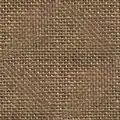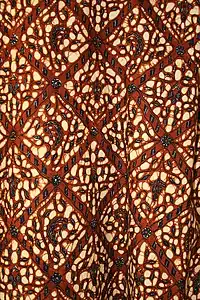Conductive textile
A conductive textile is a fabric which can conduct electricity. Conductive textiles can be made with metal strands woven into the construction of the textile or by conductive yarns which are conductive thanks to a metal-coating. There is also an interest in semiconducting textiles, made by impregnating normal textiles with carbon- or metal-based powders.[1]
Conductive fibers consist of a non-conductive or less conductive substrate, which is then either coated or embedded with electrically conductive elements, often carbon, nickel, copper, gold, silver, titanium or PEDOT. Metals may be deposited chemically with autocatalytic chemistry,[2] printed with conductive nanoparticle inks,[3] or applied with physical vapor deposition methods.[4] Substrates typically include cotton, polyester, nylon, and stainless steel to high performance fibers such as aramids and PBO. Straddling the worlds of textiles and wires, conductive fibers are sold either by weight or length, and measured in denier or AWG.
Because of the rapid growth in the kinds of conductive fibers and the uses of these fibers, a trade association--the Conductive Fiber Manufacturers Council[5]--was formed to increase awareness, utilization, and possibly standardize terminology.
Applications

Uses for conductive fibers and textiles may include static dissipation, EMI shielding,[6] signal and power transfer in low resistance versions, and as a heating element in higher resistance versions. Their benefits over solid or stranded metal wires come from conductive fibers' flexibility and ability to use them in existing textile and wire machinery (weaving, knitting, braiding, etc.).
One major use is by Micro Coax's ARACON™ fiber built on a KEVLAR® base, and used for shielding cabling in air- and spacecraft and other specialty purposes where light weight, high strength, and high-frequency shielding is imperative. Another more recent use is in the production of 'stun gun' or Taser-proof clothing, where the conductive textile forms a flexible Faraday cage in a layer of the garment. Conductive fabric can also be used to make electrodes for EEG and other medical applications;[7] such electrodes were used in a commercially available sleep-monitoring device made by former company Zeo, Inc. Highly conductive stainless steel fiber is available.[8]
See also
References
- "Tech Exchange". Archived from the original on 2010-05-10. Retrieved 2010-01-10.
- Grell, Max; Dincer, Can; Le, Thao; Lauri, Alberto; Nunez Bajo, Estefania; Kasimatis, Michael; Barandun, Giandrin; Maier, Stefan A.; Cass, Anthony E. G. (2018-11-09). "Autocatalytic Metallization of Fabrics Using Si Ink, for Biosensors, Batteries and Energy Harvesting". Advanced Functional Materials. 29: 1804798. doi:10.1002/adfm.201804798. ISSN 1616-301X.
- Chiolerio, Alessandro; Rajan, Krishna; Roppolo, Ignazio; Chiappone, Annalisa; Bocchini, Sergio; Perrone, Denis (2016-01-11). "Silver nanoparticle ink technology: state of the art". Nanotechnology, Science and Applications. 9: 1–13. doi:10.2147/nsa.s68080. ISSN 1177-8903. PMC 4714735. PMID 26811673.
- Yang, Yu; Huang, Qiyao; Niu, Liyong; Wang, Dongrui; Yan, Casey; She, Yiyi; Zheng, Zijian (2017-02-24). "Waterproof, Ultrahigh Areal-Capacitance, Wearable Supercapacitor Fabrics". Advanced Materials. 29 (19): 1606679. doi:10.1002/adma.201606679. ISSN 0935-9648. PMID 28234421.
- "Conductive Fiber Manufacturers Council". www.cfibermfg.com. Retrieved 18 April 2018.
- http://www.fibtex.lodz.pl/48_13_47.pdf
- "Pressure support system with dry electrode sleep staging device". google.com. Retrieved 18 April 2018.
- https://books.google.com/books?id=6GRovXHas_MC&pg=PA993&lpg=PA993&dq=Highly+conductive+stainless+steel+fiber&source=bl&ots=FNRAz-4vrn&sig=Kf8yNYiUme85vPhrclGYhFKLlns&hl=en&sa=X&ei=wlexU7DXJIKp0QW_sYGIAg&ved=0CDcQ6AEwATgK#v=onepage&q=Highly%20conductive%20stainless%20steel%20fiber&f=false Skotheim, Terje A. Handbook of Conducting Polymers, 2nd ed., CRC Press, 1997, p993


.svg.png.webp)